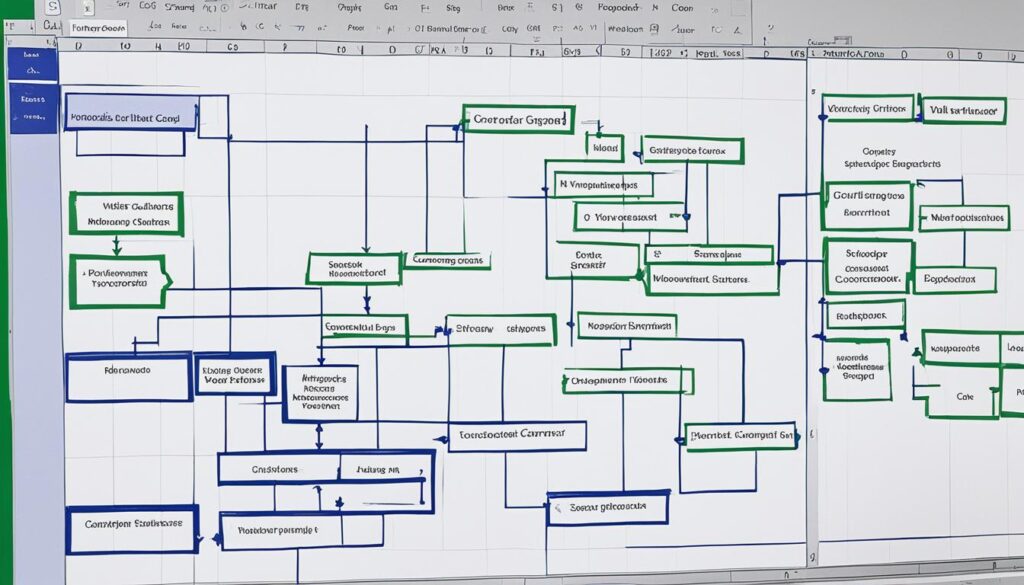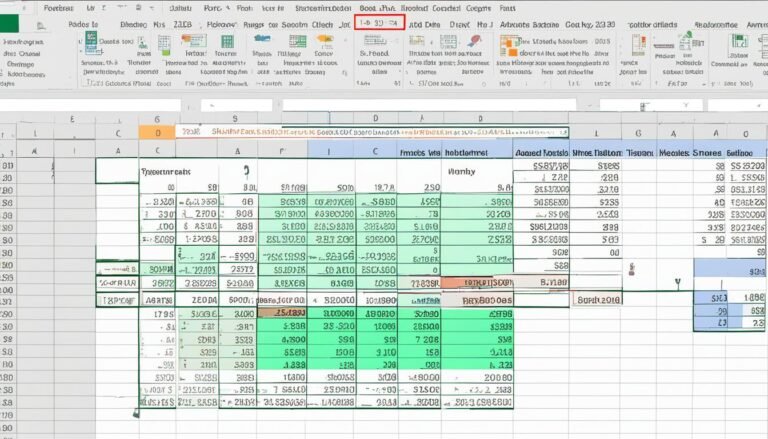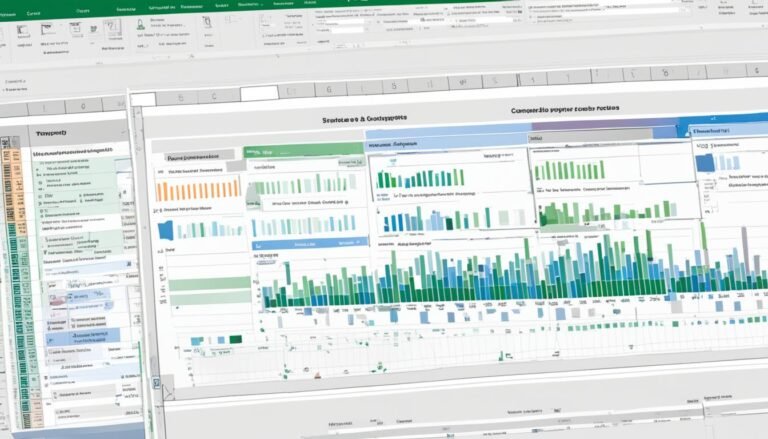How to Make a Flow Chart in Excel – Easy Steps
Being an expert in MS Excel, I’ve taught it for over 12 years. I find making flow charts in Excel easy. It’s a great way to show processes visually. This is helpful for both businesses and individuals.
Although we mainly use Excel for data, its shapes gallery is diverse. This means you can make flow charts just like you would in Visio. With just a few clicks, you can create complex flow charts for better understanding and productivity.
A flow chart in Excel shows a process using shapes and arrows. There are four main shapes: process, decision, terminator, and arrows to connect them. Using these, you can make detailed flow charts that everyone can follow easily.
Key Takeaways
- Excel’s shapes gallery makes creating flow charts easy.
- Flow diagrams use shapes and arrows to show processes.
- Its main shapes include process, decision, and terminator.
- With basic formatting, you can make professional flow charts in Excel.
- This can boost understanding and productivity.
What is a Flowchart?
With over 12 years of MS Excel experience, I know its best feature is the flow chart in excel. A flowchart helps map out processes, workflows, and decisions clearly.
Definition and Purpose of Flowcharts
A flow diagram in excel uses shapes and arrows to show processes. Each shape is a step or decision. Arrows show how steps connect. Flowcharts make complex processes easy to understand visually. This helps with communication, analysis, and improvement.
Advantages of Using Flowcharts
Flowcharts make information clear and easy to understand. They turn complex ideas into simple, actionable steps. This improves problem-solving and boosts productivity by making sure tasks run well. Some benefits of flowcharts are:
- Enhancing comprehension and communication of complex processes
- Identifying bottlenecks or inefficiencies in existing workflows
- Streamlining decision-making procedures
- Facilitating training and knowledge transfer
Common Flowchart Shapes and Symbols
The main flow chart shapes in excel include:
- Process: A rectangular shape shows a specific step or task.
- Decision: A diamond shape shows where a decision is needed.
- Terminator: A rounded rectangle marks the start or end of the process.
- Arrows: They connect shapes to show the process flow.
With these shapes and more, you can create detailed visuals for any process or workflow.
Preparing Excel for Creating a Flowchart
Before you begin making a simple flow chart in Excel, you need to set up Excel right. Make sure your spreadsheet is ready for a smooth visio like flow chart in Excel experience. Just a few quick steps will pave the way.
Formatting the Grid
Start by fixing the grid in Excel. This ensures your flow chart tutorial excel looks neat. Make columns as wide as the rows are high. This tweak keeps your shapes looking right.
Enabling Snap to Grid/Shape Alignment
The “Snap to Grid” function is a big help for a simple flow chart in Excel. It automatically adjusts your shapes to fit the grid, keeping everything tidy. To turn this on, visit the “View” tab and select “Snap to Grid.”
Adjusting Page Layout
Before you get started on your flow chart tutorial excel, set the page layout right. This step makes sure your flowchart looks good on the page. Adjust margins, choose how the page is laid out (portrait or landscape), and set the size. Doing this helps create a clear and visio like flow chart in Excel. It avoids any mess or squeezing onto the page.
Adding Flowchart Shapes in Excel
Creating flow charts in Excel involves two main ways to add shapes. You can use SmartArt graphics or select individual shapes. Let’s look at both methods.
Using SmartArt Graphics
SmartArt in Excel is a great tool for quickly adding flow chart shapes. First, click on the Insert tab, and then choose SmartArt. There, you’ll see many flowchart templates, varying from simple to complex ones.
Select a template and edit the text as you like. You can also change the layout easily. SmartArt is perfect for a methodical creation of flow charts in Excel.
Using Individual Shapes
For more creativity, use the shapes from the gallery. Click on the Insert tab, and then Shapes to see the collection. You’ll find shapes like processes and decisions, plus arrows for connections.
Place each shape as needed on your sheet and adjust its look. This way, you’re in full control of your flowchart’s design and layout.
Excel has all you need to make detailed flow charts in Excel. This helps show workflows and processes in an engaging way.
Inserting Text and Connecting Lines
After you’ve placed the shapes on Excel, it’s time to add text and lines. This step helps you create flow chart excel that clearly show your process or workflow.
Adding Text to Shapes
To put text in a shape, simply click inside it. You’ll see a blinking cursor, showing you can start typing. Write what you need, like a step or decision point. You can also change the font’s style, size, and color from Excel’s Home tab.
Connecting Shapes with Lines
It’s important to connect the shapes with lines to show your process flow. Start by clicking the Insert tab, then Shapes. You can pick from various line types, like straight lines or arrows. Choose an arrow to show the process’s direction.
With the line style set, draw the connector by clicking, holding, and dragging. Excel’s visio like flow chart in excel feature makes connecting shapes smooth. Your diagram will look professional in no time.
Following these steps, you can add text and lines to your shapes. This makes your process or workflow clear right within Excel.
Formatting and Customizing the Flowchart
First, add the basic shapes and connectors in your professional flow chart in Excel. Then, work on the look of your chart. This makes the information clear and gives it a visio like flow chart in Excel style.
Changing Colors and Styles
Use Excel’s tools to change colors and styles. You can pick different colors for shapes and fonts. Try out various styles to make your chart look better and clear.
Adjusting Line Thickness and Transparency
Focus on the lines linking your shapes. You can make these lines bold or light. It’s also possible to make shapes and lines see-through. This gives your chart a cool, new look.
I’ve been teaching flow chart tutorial excel for 12 years. I always say, take time to make these small changes. It makes your chart look better and helps people understand it more easily.
flow chart in excel
I’m an expert in Microsoft Excel with over 12 years of experience. I’ve taught its use to many people and companies. I think the built-in features for creating flowcharts in Excel are very useful.
They’re not as advanced as specialized tools. But, Excel lets you make your create flow chart diagrams inside the spreadsheet itself.
Microsoft Excel provides a shapes library and formatting options that enable you to build simple flow chart in excel visuals with relative ease.
Here’s how you’d usually do it:
- First, set up the grid and page layout.
- Then, pick flowchart shapes from the Shapes menu.
- Add text and connect the shapes with lines.
- Finally, adjust colors, styles, and line thickness.
Excel isn’t as good as other tools made for charting.
But, it’s great for a quick look at processes, steps, and how tasks flow in your work. You get to do it all inside your spreadsheets.

For easy excel flow chart examples, like showing office rules or basic decisions, Excel is perfect. However, for more tricky needs or fancy charts, look into other flowchart software.
| Flowchart Type | Excel Suitability |
|---|---|
| Basic process flows | Suitable |
| Complex decision trees | Limited |
| Cross-functional workflows | Limited |
| Collaborative diagramming | Not suitable |
To sum it up, Excel isn’t the best for making charts but it’s good enough for simple needs. When you quickly want a chart in your spreadsheet, it does the job well.
Saving and Exporting the Flowchart
After making your professional flow chart in Excel, saving it is key. This way it can be used later or shared easily. You just need to follow a few steps to keep your work ready for different uses.
Saving as a Template
Saving as a template lets you keep your flow chart tutorial excel reusable. It keeps the design and setup so you don’t have to start from scratch. Just pick “Save As Template” from the File menu and give it a good name.
Exporting to Other File Formats
Sometimes you need your simple flow chart in excel in Word or PowerPoint. Excel makes this transfer easy. You can paste it into those apps or save your chart as a PDF or XPS file for smooth sharing.
These steps help your flowcharts stay handy and ready for any use. No matter where you need them, they’ll be usable.
Alternatives to Creating Flowcharts in Excel
I’ve spent over 12 years showing people Excel’s flowcharting basics. But I know it doesn’t do everything. For advanced visual collaboration, ClickUp shines. This tool combines Mind Maps and Whiteboards for better professional flow chart design.
Using Mind Maps in ClickUp
In ClickUp, Mind Maps help organize your ideas into doable tasks. You connect these to your flow diagram in Excel. This makes brainstorming visually appealing and effective. It’s perfect for creating a visio like flow chart in Excel.
Using Whiteboards in ClickUp
ClickUp’s Whiteboards are great for team brainstorms. They offer a freehand space for idea visualization as you plan. Everyone can draw and use sticky notes together. Then, you can turn these sessions into a neat professional flow chart in Excel.
In ClickUp, these features help make your flowcharts standout. They boost teamwork, organize your work better, and make your final chart look good.
Tips for Effective Flowchart Design
Being skilled in Excel and teaching for over 12 years, I know how crucial good flowchart design is. A well-made flowchart makes it easier to understand things and boosts work efficiency. It shows processes, steps, and how things flow clearly.
To make a simple flow chart in Excel that clearly shows your thoughts, use these ideas:
- Keep things simple and neat. Use the same shapes, colors, and lines in your chart.
- Place the shapes in a logical order, from the start to the end of your flowchart. Make sure there’s enough space around each shape so it’s easy to read.
- Add text inside the shapes to explain what each step means. But don’t put too much text in there.
- Include special symbols for decisions or documents. This makes your flowchart even clearer.
- Always look over your work and tweak it as needed. Make sure it’s easy for anyone to understand.
With these steps, you’ll make a great flowchart. It will be clear, look good, and help others understand your workflow. This makes working with others easier.
Remember, a well-designed flowchart can turn complex information into a clear and concise visual representation, enhancing communication and collaboration within your team or organization.
Real-World Examples and Use Cases
I have been an MS Excel expert for over 12 years. In my experience, create flow chart excel diagrams have helped in many areas. They are valuable for showing how complex work and processes happen. Project management and manufacturing processes rely on them a lot.
In IT, flow diagram in excel are key. They help professionals find and fix technical problems. Customer service teams use them too. Flowcharts help these teams follow the same steps when dealing with customer questions and problems.
When looking to improve a business, excel flow chart examples are very useful. They help find where things slow down and how to make work smoother. In finance and marketing, decision trees are a big help. They help look at different situations to make the best choices.
Well-designed flowcharts enhance understanding, standardize procedures, and improve productivity across industries.
Flowcharts are also big in training documentation. They make hard ideas and processes easier to understand. This is great for new team members or customers. Seeing things visually really helps people remember and learn.
- Project Management
- Manufacturing Processes
- Customer Service Workflows
- IT Troubleshooting Guides
- Business Process Mapping
- Decision Trees
- Training Documentation
Conclusion
After over 12 years of teaching MS Excel, I’ve seen its power for simple flow chart in excel creation. Excel is perfect for making basic diagrams in spreadsheets. It’s not as advanced as other apps, but it does the job well for quick create flow chart excel needs.
Yet, for advanced flow chart tutorial excel needs, I suggest looking into ClickUp. ClickUp shines in making detailed flowcharts and diagrams. It has tools like Mind Maps and Whiteboards for better visual planning and brainstorming.
Excel’s flowchart tools, though basic, are great for sharing ideas fast. This is especially true with its data analysis features. But if you want more from your diagrams, apps like ClickUp offer a lot more. They make it easier to visualize processes and work together smoothly.
FAQ
What is a flowchart?
A flowchart is a visual diagram. It uses shapes and arrows to show a series of steps, processes, or decisions. The shapes include process, decision, and terminator symbols. They are connected by arrows.
Why use flowcharts?
Flowcharts make complex ideas easy to understand quickly. They are efficient tools that help streamline actions. This leads to problem-solving and increased productivity because everything is clear and organized.
How do I prepare Excel for creating a flowchart?
To create a flowchart in Excel efficiently, adjust the grid first. Make columns match row size for even shapes. Turn on the “Snap to Grid” option. This helps with shape alignment. Also, set the page layout to fit everything nicely on one page.
How do I add flowchart shapes in Excel?
You can insert flowchart shapes in Excel using SmartArt or by selecting shapes individually. SmartArt offers ready-made templates. For single shapes, visit the Insert tab. Then, choose from various shapes to manually include them.
How do I insert text and connect shapes in a flowchart?
Start by clicking inside a shape to add text. Customize the text format using the options in the Home tab. To link shapes, select the Lines option under Shapes. Choose an arrow style for the connectors. Drag to connect the shapes.
How can I format and customize the flowchart?
To make your flowchart look unique, customize the colors and styles of the shapes and lines. Use the options on the ribbon to change fill color, line thickness, and more. This can give your flowchart a professional touch.
How do I save and export my flowchart from Excel?
When you finish your flowchart in Excel, save it as a template if you might reuse it. Use the Save As Template option under the File menu. To use it in other programs, copy it or save in a compatible format like Word or PowerPoint.
Are there alternatives to creating flowcharts in Excel?
In addition to Excel, ClickUp offers powerful tools for visual collaboration. It has Mind Maps and Whiteboards. These features help teams work more creatively and effectively on projects.
What are some tips for effective flowchart design?
Keep your flowchart neat and easy to follow by using the same shapes, colors, and connectors. Arrange everything logically. Include enough white space. Use clear but concise text. Symbols for different functions can make things even clearer. Don’t forget to review and refine your design as needed.
What are some real-world examples and use cases for flowcharts?
Flowcharts are versatile and are used in many fields. They are helpful in project management, manufacturing, customer service, IT, and business processes. They are also used for decision-making, training, and mapping out complex procedures. A well-designed flowchart can make any process easier to understand and follow.





